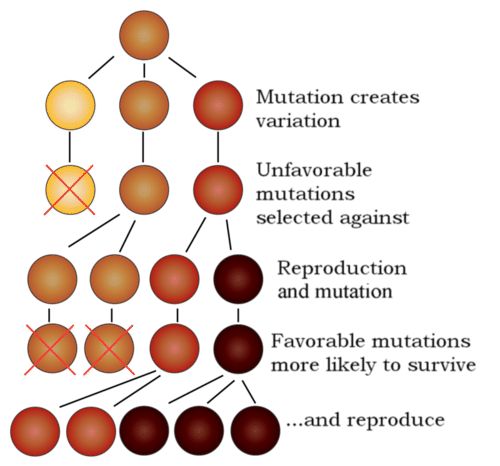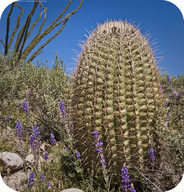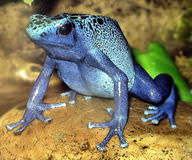17.4种群的适应和进化
Section outline
-
Why would an organism match its background? Wouldn't it be better to stand out?
::为什么一个有机体要符合其背景?An organism that blends with its background is more likely to avoid predators . If it survives, it is more likely to have offspring. Those offspring are more likely to blend into their backgrounds. This butterfly appears to be well adapted to its environment. It is less likely to be eaten by a bird than a butterfly that stands out against the tree.
::混合其背景的有机体更有可能避免捕食者。 如果它生存下来, 它更有可能有后代。 这些后代更有可能融入他们的背景。 这只蝴蝶似乎很适合它的环境。 它被一只鸟吃掉的可能性要小于一只站在树边的蝴蝶。Variation and Adaptation
::变化和适应Every organism is different from every other organism. Every organism's genes are different, too.
::每个生物体与其他生物体不同 每个生物体的基因也不同Variations
::变式There are variations in the traits of a population . For example, there are lots of variations in the color of human hair. Hair can be blonde, brown, black, or even red. Hair color is a trait determined by genes.
::人口特征各有不同。 比如, 人类头发的颜色有很多不同。 头发可以是金发、 棕色、 黑色甚至红色。 发色是由基因决定的特征 。Mutations
::变异At some time in the past, a variation probably came from a mutation . A mutation is a random change in an organism's genes ( Figure ). Mutations can be triggered by radiation or chemical changes in the environment, but most occur naturally. A mutation can be beneficial, neutral, or harmful. If the mutation is beneficial, that organism may have a better chance to survive. An organism that survives is likely to have offspring. If it does, it may pass the mutation on to its offspring. The offspring may be more likely to survive.
::在过去的某个时候,变异可能来自突变。变异是一个生物基因的随机变化(图 )。变异可能由环境的辐射或化学变化引发,但大多是自然发生的。变异可能有益、中性或有害。如果变异有利,则该生物可能拥有更好的生存机会。存活下来的有机体很可能有后代。如果变异是随机变化,则会将变异传给后代。后代可能更可能存活下来。Genetic mutation is central to the creation of biological diversity. Adaptations
::适应Some of the characteristics an organism has may help it survive in its environment. These characteristics are called adaptations .
::生物体的某些特征可能有助于其在环境中生存,这些特征被称为适应。Many adaptations protect organisms from the external environment ( Figure ).
::许多适应措施保护有机体免受外部环境的影响(图)。Cacti have thick, water-retaining bodies that help them conserve water. Other adaptations help an organism move or gather food. Reindeer have sponge-like hooves that help them walk on snowy ground without slipping and falling. Fish at the bottom of the ocean are tiny and use very little energy because there is very little food. Organisms have special features that help them avoid being eaten. Some frogs are poisonous, and their bright colors serve as a warning ( Figure ). Some plants also have poisonous or foul-tasting substances in them that keep animals from eating them. For example, the distinctive smell of mint deters insects.
::其它的适应帮助有机体移动或收集食物。 驯鹿有海绵般的蹄子,可以帮助他们在雪地上行走而不会滑落和坠落。 海底的鱼类很小,由于食物很少,使用能量很少。 生物有特殊特征,可以避免被食用。 一些青蛙有毒,它们的亮色可以作为警告(图 ) 。 一些植物中也有有毒或污秽物质,可以防止动物吃它们。 例如, 薄荷的香味会吓唬昆虫。Poison dart frogs have toxins in their skin. Their bright colors warn potential predators not to take a bite! How Adaptations Develop
::适应如何发展Adaptations develop this way. Think about a population of oak trees. Imagine that a fungus has arrived from Asia to North America. Most of the North American oak trees are killed by the fungus. But a few oak trees have a mutation that allows them to survive the fungus. Those oak trees are better adapted to the new environment than the others. Those trees have a better chance of surviving. They will probably reproduce. The trees may pass on the favorable mutation to their offspring. The other trees will die. Eventually, the population of oak trees will change. Most of the trees will have the trait to survive the fungus. This is an adaptation. Over time, traits that help an organism survive become more common. Traits that hinder survival eventually disappear.
::以这种方式发展适应性。 想象一大批橡树。 想象一棵真菌从亚洲运到北美。 大多数北美橡树被真菌杀死。 但是, 少数橡树有突变, 能够生存真菌。 这些橡树比其他树更适合新环境。 这些树有更好的生存机会。 这些树可能会繁殖。 这些树可能会把有利的变异传给后代。 其他树木会死。 最终, 橡树的数量将会改变。 大多数树将具有生存真菌的特性。 这是适应性。 随着时间的推移, 帮助生物生存的特征会变得更为常见。 阻碍生存的陷阱最终会消失。Thousands of northern elephant seals—some weighing up to 4,500 pounds—make an annual migration to breed each winter at Año Nuevo State Reserve in California. Marine biologists are using high-tech tools to explore the secrets of these amazing creatures.
::数千头北部大象海豹 — — 有些甚至高达4500磅 — — 每年在加利福尼亚州Año Nuevo州立保留地进行一年一度的迁徙,每年在冬季繁殖。 海洋生物学家正在利用高科技工具探索这些神奇生物的秘密。Summary
::摘要- Different members of a population have different genes for the same trait.
::不同的人口成员具有不同基因的同一特性。
- Some of these differences are due to mutations.
::其中一些差异是由于突变造成的。
- Some traits allow an individual organism to be better adapted to its environment. That individual will be more likely to survive and to reproduce.
::某些特性使个体生物能更好地适应其环境,该个体更有可能生存和繁殖。
Review
::回顾- How do adaptations develop?
::适应工作如何发展?
- What does it mean to say that an organism is well adapted to its environment?
::说一个有机体适应其环境是何谓?
- What is a mutation?
::什么是突变?
- Different members of a population have different genes for the same trait.



